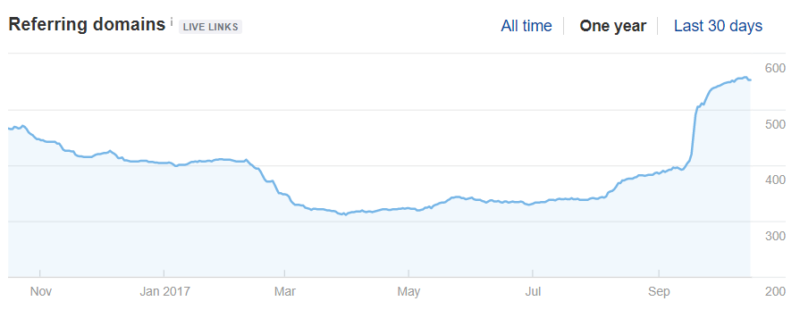
SEO is a long-term strategy.
It takes time to build authority and reputation, and spammy tricks that work for a short time are eventually devalued by the search engines.
However, we’ve found a strategy that’s delivered results relatively quickly and proven particularly effective in the B2B space.
Some of our best projects have seen near double traffic growth:

Not surprisingly, this traffic growth corresponds with our efforts to secure links. Here is a look at the trends for referring domains to the site above (via Ahrefs):

Of course, seeing a case study where links helped grow traffic isn’t earth-shattering. But I want to share the strategies we used to achieve these results so you can experiment with them on your own site.
Our strategy included:
- analyzing competitive content.
- expanding topics to build linkable assets.
- building targeted pages and resources.
- identifying opportunities for hyper-relevant, linkable content.
These were the four cornerstones of our process.
To better demonstrate these strategies, I’ll reference a hypothetical example throughout the post. Since our project was in the B2B space, I’m choosing a B2B brand for my example: Absorb LMS, a learning management system for employee training (not a client).

Without further ado, let’s dive into the process we used to grow traffic in the B2B sector by 192 percent in roughly five months.
Analyzing competitor content and pages
We started by examining what was working for our client’s competitors.
There are a wide variety of excellent tools available for competitive analysis — for our project, we used Ahrefs to analyze competitors’ top pages. By analyzing competitors’ top content, we could identify keyword gaps on our client’s site, as well as low-difficulty opportunities.
For our client, we focused on larger (respective to their niche) search volumes first and worked our way down from there, but there is no set search volume that’s appropriate for every strategy. Instead, consider your niche and the potential value of capturing leads from a given search result. If one lead is potentially worth thousands of dollars, you don’t need much volume to justify the value of ranking for that term.
For Absorb, competitor content analysis would involve scrutinizing competitors such as:
- TalentLMS
- Litmos
- Bridge
- Docebo
- Growth Engineering
- Dokeos LMS
- Administrate
For example, looking at Bridge in Ahrefs, I can see some of their top pages define various eLearning terms:

It appears TalentLMS has similar pages that are performing well, and they are also securing traffic from e-learning subtopics like [authoring tool], [constant learning] and [microlearning].

From just a quick glance at these competitors in Ahrefs, I learned that Absorb could pursue some opportunities creating pages that define prominent e-learning terms or target tangentially related topics.
Since Absorb doesn’t currently have any pages like this in their top 15 pages in Ahrefs, this strategy should be a real consideration.

If Absorb were really a client, I would analyze all their competitors to uncover trends and find as many opportunities and gaps as possible. But for this post, I’m going to move on to the next part of our strategy: building linkable assets.
Expanding topics to create linkable assets
The next step is creating highly linkable assets.
Many B2B brands work within narrow, specific niches; this was the case for our client. It’s certainly possible to secure links within these small online neighborhoods, but you can quickly exhaust all available worthwhile opportunities.
We discovered that broadening our topics gave us the opportunity to promote them to a much larger outreach market. To better understand this topic expansion, let’s consider Absorb LMS.
Absorb’s primary audience and buyers exist within the e-learning niche. However, this is a relatively small outreach market, which can mean limited exposure and links when it comes to content promotion. By expanding, I could target broader topics like:
- learning styles and the psychology of learning.
- employee benefits and retention.
- business management.
- career advancement
These topics have larger audiences, which means bigger outreach markets and more visibility, yet they’re still relevant to Absorb’s service and their audience.
A quick comparison of search volumes for the head terms of [learning management system] and [business management] in SEMrush demonstrates the difference in audience sizes:
- [learning management system] — 6,600
- [business management] — 18,100
Broader content topics will have broader appeal and provide more opportunities to secure exposure and links, while still being relevant and providing the opportunity to reach your target audience.
Building targeted pages and resources
We also built strategic pages to target the most important and relevant terms for our client.
While we wanted our linkable assets to have broad appeal, we wanted these pages to answer a very specific question or issue pertinent to the client’s business, and answer it better than any other page on the web.
To create best-in-class pages, we followed content strategy best practices such as:
- providing in-depth, long-form coverage of the topic.
- adding rich media and interactivity via sunk cost differentiators.
- maintaining a strong and consistent focus on keywords and key phrases.
- optimizing on-page factors — e.g., URLs, title tags, H1s, page speed, image optimization.
Although these resources had limited outreach markets, they also had lower competition. Because the quality of the content was high, the pages were optimized, and the competition was low, these pages could perform well in search with little promotion.
While the traffic from these pages was small in volume, it was highly qualified traffic. These pages also built credibility and overall brand awareness as our client began to show up consistently for hyper-relevant queries. It’s even possible to passively acquire links to these pages if they are the leading resource in the space.
Ideation for these pages came from a combination of the insights from competitive content analysis and keyword research.
Using my Absorb example, I could revisit competitor top pages to find direction for new page creation. For instance, TalentLMS has a page that ranks number one for [e learning technology]:

The search volume is relatively small (150), but this is a relevant term for Absorb, and ranking here would be beneficial. Furthermore, after looking at TalentLMS’s page, I’m confident Absorb could easily build something better for searchers.
The TalentLMS page is essentially one large block of text:

This is an opportunity for Absorb to create something that is best-in-class and builds authority and visibility in their niche.
Identifying when volume intersects with relevance
The combination of linkable assets with broad appeal and strategic, targeted pages built a strong SEO foundation for our client. However, the major successes came when we could identify opportunities where large search volumes corresponded with hyper-relevant topics.
These situations are less prevalent but can be extremely rewarding if you can find them. Capitalizing on these opportunities means you get the best of both worlds: increased link opportunities and the chance to rank for key terms for your business.
Regarding Absorb LMS, I would again turn to their competitors. For example, Bridge has a page that ranks on page one for the term [scorm] which has a search volume of 5,500:

Again, it appears there is an opportunity for Absorb to build something that could outperform Bridge’s page, which is just a few large chunks of text:

If Absorb built a page focused on SCORM, they could secure both links and highly relevant traffic.
Strategy recap
We achieved phenomenal results for our client with this strategy. Of course, your results will vary depending on a variety of factors (website, competition, goals) but the concepts outlined here could help you grow traffic on your own site, particularly if you operate within a very niche category in the B2B space.
To recap, our strategy involved:
- analyzing competitive content: Analyze top-performing pages on competitor sites to identify potential content opportunities.
- expanding topic groups: Broaden topics when creating linkable assets to extend the reach of those assets and target larger outreach markets.
- building strategic pages and resources: Create best-in-class pages that target hyper-relevant terms and traffic.
- identifying opportunities for hyper-relevant, linkable content: Find situations where substantial search volume intersects with highly relevant topics to secure large numbers of links and capture qualified traffic.
Hopefully, you can apply some of these strategies to your own pursuit for better search performance.
Contributing authors are invited to create content for Search Engine Land and are chosen for their expertise and contribution to the search community. Our contributors work under the oversight of the editorial staff and contributions are checked for quality and relevance to our readers. The opinions they express are their own.



